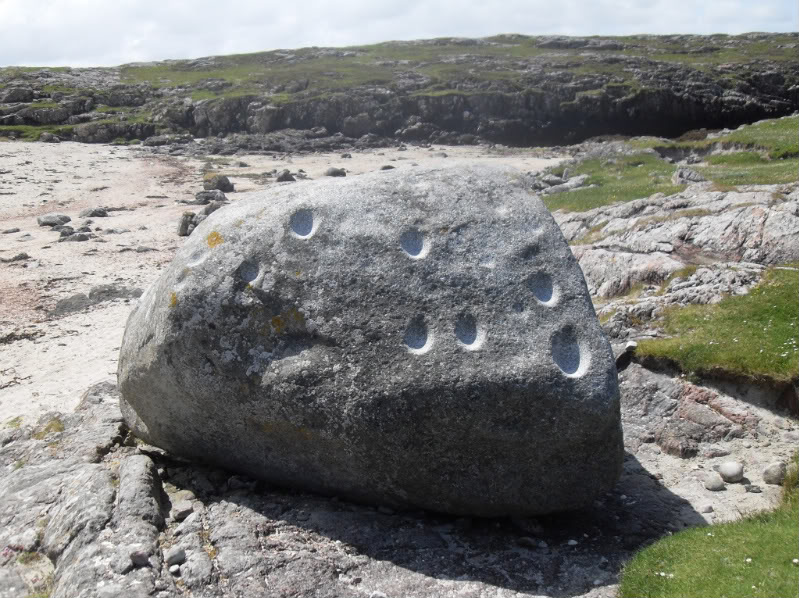The Isle of Tiree of the Inner Hebrides is a stretch of green machair in which myriads of yellow buttercups emerge, a land almost completely flat that houses seem to rise from the sea; the island is always sunny and the strong winds assist windsurfers and kitesurfers, even keeping mosquitoes away!
In the nineteenth century Tiree counted 4500 ab definitely too much for its resources, so the duke of Argyll implemented assisted migration (in fact a typical maneuver by Highland Clearances) and between 1841 and 1881 more than 3600 people emigrated to Canada, United States, Australia and New Zealand.
In Gaelic it is called “tir-lodh” – ‘the land of corn’ from the days of the 6th century Celtic missionary and abbot St Columba. Tiree provided the monastic community on the island of Iona, south east of the island, with grain, and it seems that several monks settled there at St Patrick’s Chapel, Ceann a ‘Mhara and Soroby.
THE SOUND OF ANCIENT SCOTLAND
:format(jpeg):mode_rgb():quality(40)/discogs-images/R-11943063-1525349797-5318.jpeg.jpg)
Tiree is an island with ancient settlements, renowned for its Clach a’Choire (the stone cauldron) or even Choire Fhionn MhicChumhail (the cauldron of Finn mac Cumaill). The name identifies a natural amphitheater near the village of Balephetrish (Vaul), a probable mythical center in prehistoric and medieval times, where the Ringing Stone is found, which emits a sharp and metallic sound similar to that of the gong or the bells when it is hit: the stone looks like a big egg on the spoon, legend has it that the boulder was thrown by a giant of Mull and if ever it was split the island would sink into the sea.
...a ‘rock gong’ similar to Clach a’ Choire, listed by John MacKenzie (1845, p8) as one of the seven wonders of Scotland – a huge granite erratic covered with 53 cupmarks, the deepest of which are at the most resonant parts of the stone…According to Fagg (1997 p86), Clach a’ Choire was ‘said to contain a crock of gold – but if it ever split Tiree will disappear beneath the waves.’ If true (Mrs Fagg mistakenly attributes the staement to SHIS) the legend thus contains both a motive for destroying such stones and a warning against doing so…Compare Newton 1992 p145 where it is claimed that if Clach a’ Choire ‘ever shatters or falls off the pedestal of small stones on which it rests, Tiree will sink beneath the waves.’ (from The Gaelic Otherworld, ed Ronald Black, here)
The Kilmartin Sessions: The Sounds of Ancient Scotland

Photographic reportage from The Crow Clan here
The island is dedicated a love song of the late nineteenth century titled Tiree love song, a song originally written in Gaelic by Alexander Sinclair (Alasdair Neaill Oig), a wine and spirits merchant in Glasgow but a devoted “Tireeman”, being his family originally from the island.
SCOTTISH GAELIC VERSION: Am Falbh Thu Leam a Rìbhinn Òg (Will you come and go with me?)
In the song, he asks a young maiden to come with him over the sea where she will see everything she could desire in the isle of the west that once was his home: geese and white swans, views over the ocean to the neighbouring isles, the green meadows and the tranquillity of St Patrick’s chapel.He tells her of the songbirds, the bumble bees and the blaze on the cattle, the cormorants and ducks, the marram grass growing on the dunes and the fragrance of the machair flowers, all to be found on his favourite part of Argyll – the green island of Tiree.
The island abounds with ancient prehistoric remains or dating back to the time of St. Columba, next to the temple of St. Patrick we also find an ancient well with healing waters. Click on names on the interactive map in http://www.tireeplacenames.org/ to visit them all!!

Effie MacDonald of Middleton
Séist
Am falbh thu leam a rìbhinn òg
No’n téid thu leam thar saile
Gum faic thu ann gach nì gu d’ mhiann
‘S an eilean shiar a dh’fhàg mi.
1
Ged nach faic thu coill’ no fiadh
Tha gèadh is eala bhàn ann
Cait’ bheil sealladh a chuain shiar
Nuair bhios na liadhan traighte.
2
Chì thu uiseag agus smeòrach
Lon dubh agus luachran
Seillean ruadh le mhil ‘s a ghàradh
‘S blàrag air gach buallan.
3
Chì thu sgairbh ‘tigh’nn ort o’n chuan;
Tha lachaidh ruadh a’ snamh ann;
Muran gorm a’ fàs m’ a bhruaich
Gach ceum mu ‘n cuairt d’ a’ thraighean
4
Cha ‘n fhaic thu nathair ann air grunnd
Ach luibhean ‘s cùbhraidh faileadh
A’ cinntinn ann bho linn gu linn
‘S an tìr ‘s an d’fhuair mi m’ àrach
ENGLISH “VERSION” Tiree love song
The transposition in English is by Hugh S. Roberton, already the author of the very popular songsThe Mingulay Boat Song, Westering Home and Mairi’s Wedding, who makes a text re-elaboration rather than a translation and publishes it in his book Songs of the Isles (1950)
The Corries
Ryan’s Fancy (II, I, III)
CHORUS He-ree he-ro my bonnie wee girl He-ree he-ro my fair one Will you come away my love To be my own my rare one I Smiling the land! Smiling the sea! Sweet is the scent(1) of the heather. Would we were yonder, just you and me, The two of us together! |
II All the day long, out on the peat (2) Then by the shore (3) in the gloaming Stepping it lightly with dancing feet And we together roaming III Laughter o’ love! Singing galore! Tripping it lightsome and airy: Could we be asking of life for more, My own, my darling Mary? |
NOTES
1) or “smell”
2) or “All together down by the sea”,
3) or “Down by the sea”
LINK
http://www.tireeplacenames.org/
http://www.tobarandualchais.co.uk/en/fullrecord/69928/1/LuckyDip
https://www.calmac.co.uk/article/6138/An-island-dream-discovering-Tiree-by-bike
http://www.aniodhlann.org.uk/wp-content/uploads/2016.14.1.pdf
http://www.aniodhlann.org.uk/sounds-clips/
http://www.aniodhlann.org.uk/object/1997-232-10/
https://mudcat.org/thread.cfm?threadid=10536
http://gestsongs.com/11/tiree.htm
